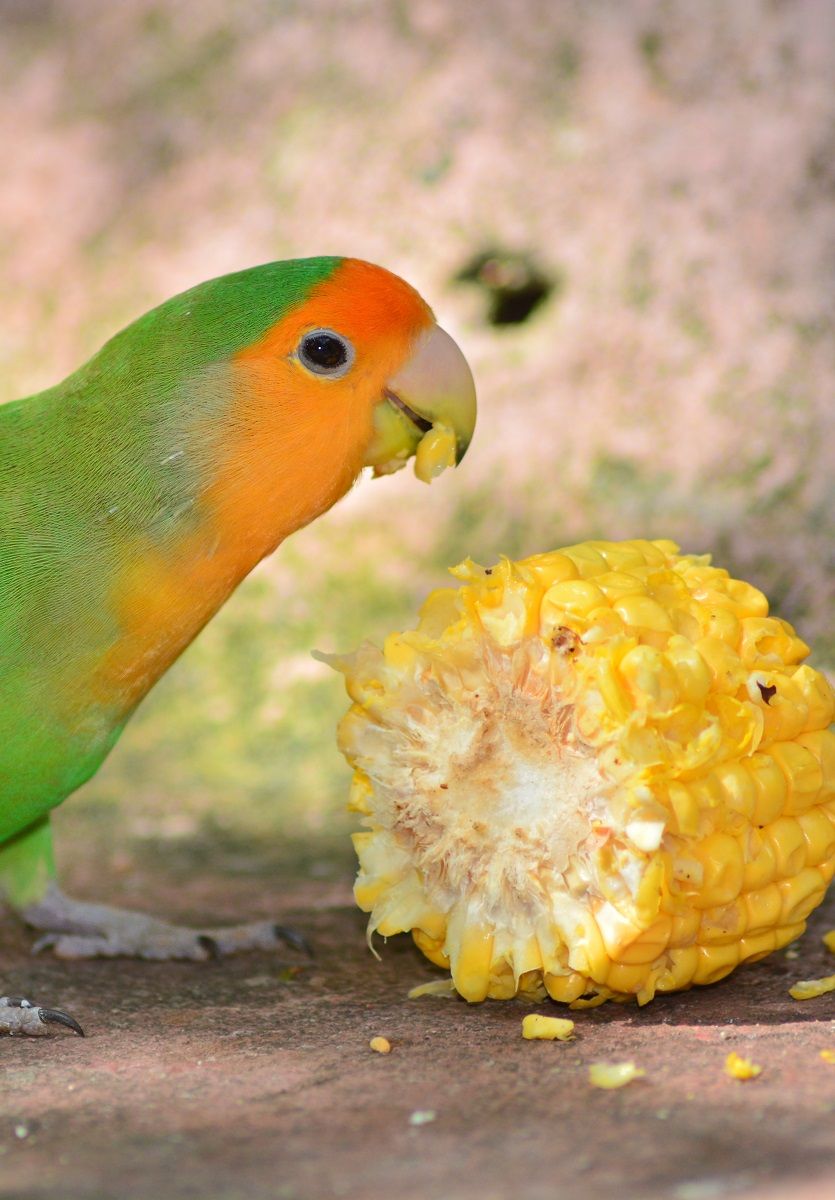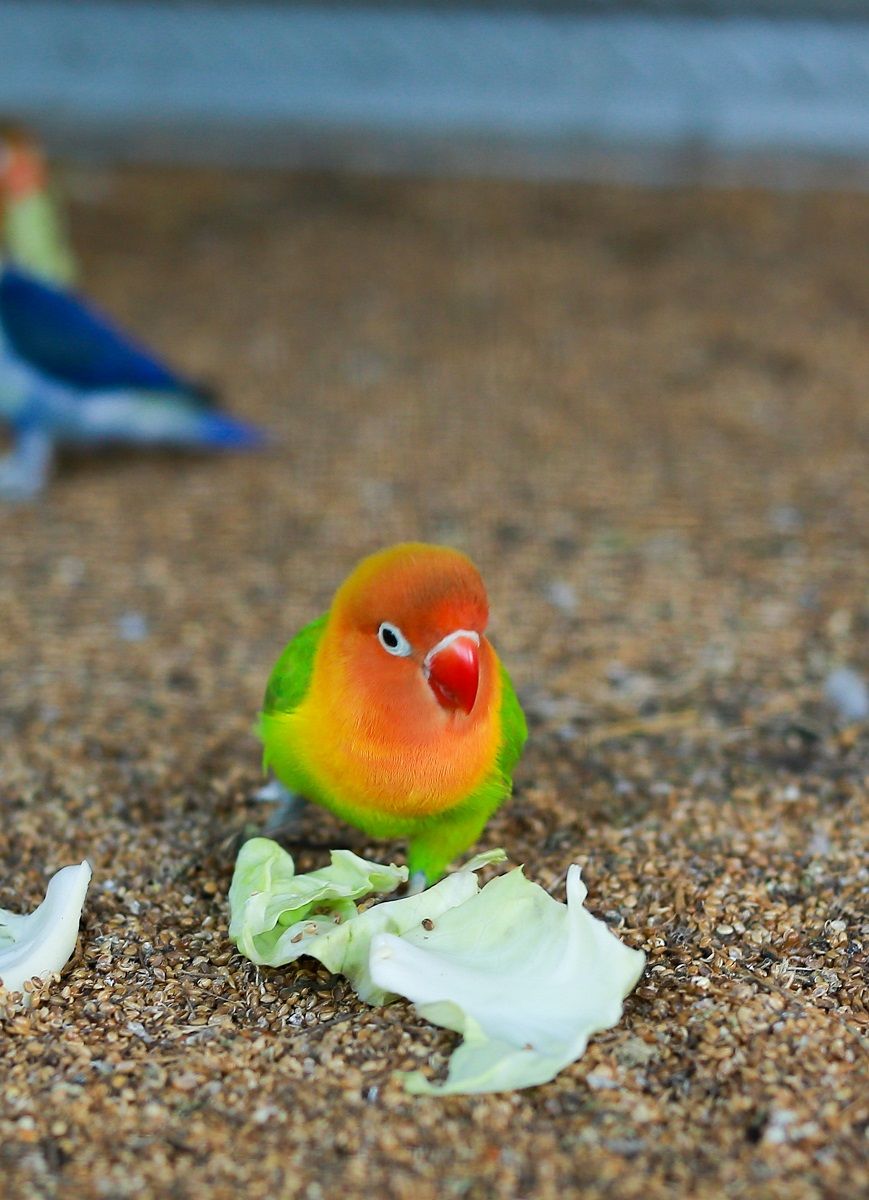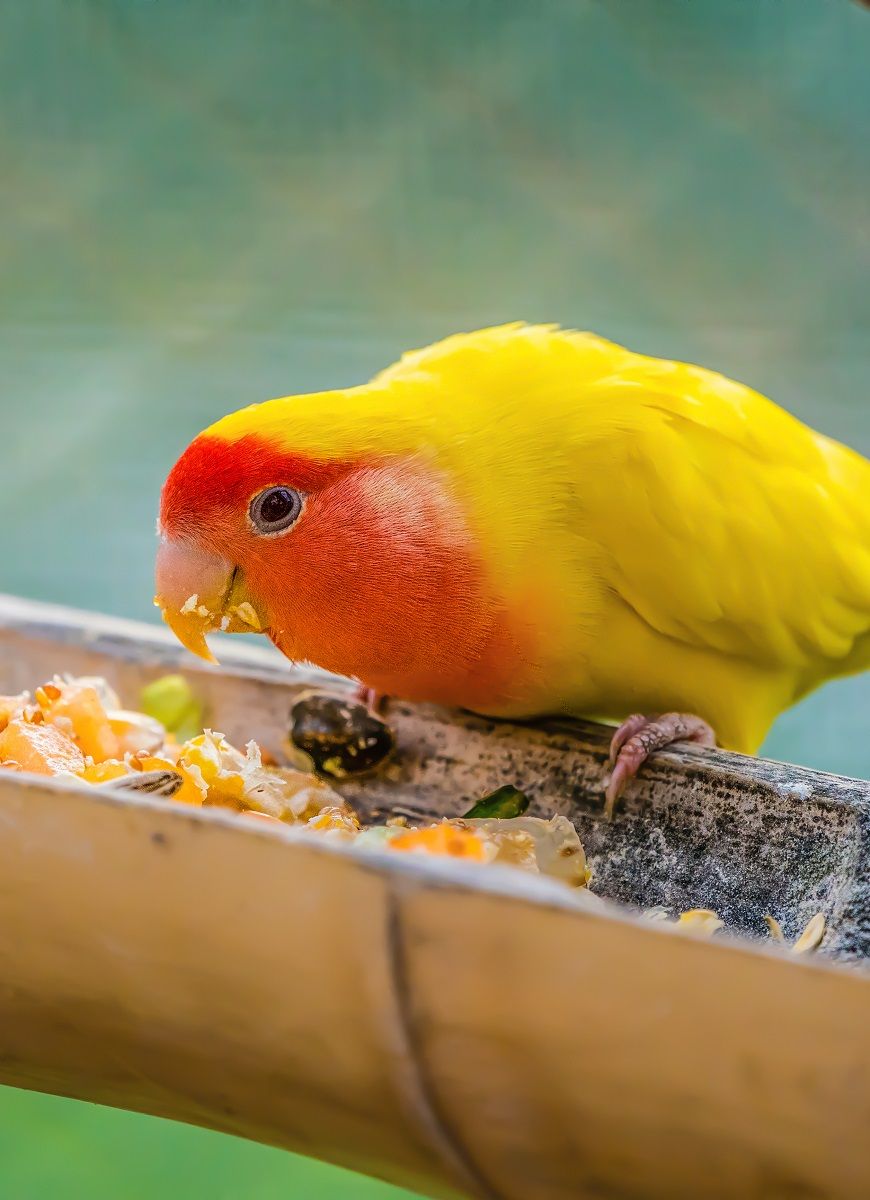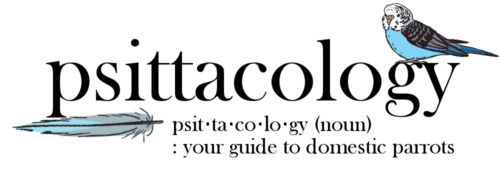Did you know that vegetables are among the healthiest things you can feed a parrot? If you’re thinking of adding a lovebird to your family or looking to add more healthy food to your bird’s diet, it’s important to know which veggies are safe for them.
Below, let’s have a look at 15 nutritious vegetables for lovebirds that your bird will love to snack on!
This post contains affiliate links. If you make a purchase, a small percentage will go directly to Psittacology at no additional cost to you. Thank you for supporting Psittacology!
15 healthy, safe vegetables for lovebirds
Can lovebirds eat carrots?
Carrots are one of the most popular vegetables for lovebirds. Most love the sweetness and the crunch, and carrots have loads of vitamin C, fiber, and other essential nutrients.
Carrots can be served whole or chopped up, but offering them whole can be a great way to provide some mental stimulation for your lovebirds. They love pecking at and shredding them! Don’t remove the carrot tops, as those are edible and very healthy.
Can lovebirds eat celery?
Lovebirds can definitely eat celery. It contains a range of vitamins like vitamins A, B9, C, and K, as well as important minerals like magnesium, potassium, and iron.
Celery is a healthy and nutritious food for lovebirds, as it is low in calories and high in water content, which can help keep your parrot hydrated. Pieces of chopped celery also make excellent treats to use for enrichment activities like foraging.
Can lovebirds eat corn?
Fresh corn kernels are a great source of vitamins A, C, and E for lovebirds. Corn is a good example of a healthy carbohydrate! Although it’s sometimes pointed out as a possible cause for yeast infections in parrot crops, this should be easy enough to avoid by not feeding it on a daily basis.
You can offer pieces of corn on the cob whole, with the husk and silk still attached, to encourage foraging behavior.

Can lovebirds eat broccoli?
Lovebirds can eat broccoli, and for some seed addicts, the little seed-shaped buds are among the only vegetables they will eat. So share a floret or two when you’re cooking up some broccoli for yourself!
Even in small amounts, broccoli has many health benefits. For example, it promotes strong, healthy bones thanks to its manganese and calcium content. Don’t throw away the stems, as your bird can eat those too.
Can lovebirds eat basil?
I know, I know, it’s not actually a vegetable but an herb. But lovebirds can in fact eat basil, and they’ll love to nibble on some fresh basil leaves. It’s a win-win situation: your parrot gets a healthy snack, and your home ends up smelling wonderfully like Italian food.
The benefits of fresh herbs for lovebirds are numerous. They support good digestive health and are rich in vitamins, minerals, and antioxidants. Buy a cheap basil plant and let your bird go to town!
Can lovebirds eat cucumbers?
Most lovebirds love to eat cucumber slices. They make great treats with plenty of valuable vitamins and minerals. Leave the skin on, as that’s the most nutritious part!
In addition to their nutritional benefits, cucumbers can also provide lovebirds with a fun and enriching activity. They can be fed in small pieces and offered as an all-natural foraging toy. Zucchini should also work fine.
Did you know? A hanging fruit and veg skewer is a fun and different way to present fresh produce to your lovebird.
Can lovebirds eat lettuce?
Lovebirds can enjoy lettuce as part of a healthy, balanced diet. It’s a good idea to choose organic lettuce when shopping for your feathered friend, or at least make sure the lettuce is rinsed thoroughly (and patted dry with a clean paper towel) to remove pesticide residue before feeding.
Iceberg lettuce is best avoided due to its low nutritional value, with romaine lettuce being a more wholesome choice. You can also opt for butterhead, batavia, oak leaf or radicchio.
Don’t forget that due to its high water content, feeding lettuce can give your lovebird slightly watery poops. This is normal and you don’t have to worry about it. Just don’t feed loads of lettuce at once!
Can lovebirds eat cabbage?
Lovebirds can eat cabbage. It’s actually a great source of calcium as well as vitamins C and K, which are known to help protect and boost the immune system.
Cabbage can be served both raw and cooked. You can offer whole leaves or chop them into small pieces. It’s best to remove the outer layer and stem before feeding cabbage to a lovebird, as these parts can be a little more difficult to digest.

Can lovebirds eat bell peppers?
Although bell peppers may not be a natural part of a wild lovebird’s diet, these parrots can definitely safely eat them.
These colorful and vibrant fruits (yes, that’s right, bell peppers are actually a fruit!) present a great source of vitamins A and C, which are essential for your lovebird’s well-being and especially its immune system.
To prepare bell pepper for your lovebird, rinse the pepper thoroughly and pat dry to remove any traces of pesticide. No need to remove the pith and seeds: they can be consumed without causing harm. Many lovebirds appreciate the enrichment that stripping the seeds from the bell peppers provides.
Can lovebirds eat cilantro?
Feeding cilantro, also known as coriander, will not harm your lovebird. In fact, this fragrant little leafy herb is usually well-received by lovebirds and other parrots. Cilantro can boost your bird’s levels of vitamin K and vitamin C, as well as potassium.
Of course, like any other fruit, vegetable or herb, cilantro should be rinsed to remove dirt or chemical residue before feeding. If you are able to buy organic in the first place, even better!
Did you know? Coriander seeds are used as spices in some cuisines. If you have some on hand, you can offer these to your lovebird as well as a nice break from the standard parrot seed mix.
Can lovebirds eat kale?
It’s no wonder kale is such a popular leafy green – this hearty cruciferous vegetable is packed with essential micronutrients, including vitamins A and C, calcium, and fiber, which can contribute to your lovebird’s overall health.
Do keep in mind that because kale is relatively high in calcium, overfeeding may lead to calcium imbalance in lovebirds. Excess dietary calcium can predispose your bird to the development of gout, or even to the formation of kidney stones.
Since your lovebird’s kidneys are responsible for filtering excess calcium out of its bloodstream, feeding large amounts of high-calcium foods over a prolonged period of time also has the potential to cause kidney damage. So: don’t be afraid to feed kale, but stick to a small amount once a week.
Remove the tough central stem before feeding kale, as this can be challenging for lovebirds to process.
Can lovebirds eat green beans?
Green beans are a healthy addition to your lovebird’s diet, offering a fantastic source of fiber as well as a bunch of important vitamins. If you want to give your lovie some beans to try, you should select fresh, ideally organic green beans and thoroughly rinse them to clear any contaminants.
You can offer your lovebirds green beans raw or lightly steamed. Although raw green beans provide slightly higher levels of vitamins, lightly steamed or blanched beans are easier for your bird to digest.
Can lovebirds eat parsley?
Like other leafy greens, parsley is a favorite for many birds. This herb is rich in vitamins A, C and K, and also delivers a powerful antioxidant punch to help clear free radicals and naturally detoxify.
Do keep in mind that parsley isn’t the best option to feed on a daily basis. Like some other greens, it’s high in oxalates (oxalic acid specifically) which can lead to urinary tract issues or even the formation of kidney stones if your lovebird regularly eats a lot of it.
Much like kale, parsley (flat or curly) is best fed as an occasional treat. Once a week or so is absolutely fine and a great way to safely add some variety to your bird’s diet.
Can lovebirds eat spinach?
High in iron, calcium and vitamins A and K, fresh, well-rinsed spinach has loads of health benefits can be fed safely to lovebirds in small amounts. Many birds will love tearing at and shredding these glossy dark greens, so be sure to serve them whole.
Similar to parsley, spinach contains fairly high oxalate levels, which may be harmful to your lovebird’s health if fed in large quantities or too regularly.
As well as having the potential to cause urinary tract problems, oxalates bind calcium in your lovebird’s digestive tract. This prevents calcium absorption into the bloodstream. Over time, calcium deficiency can occur. Still, a spinach leaf here and there won’t hurt your bird at all!
Can lovebirds eat tomatoes?
Your lovebird can absolutely enjoy some tomato. They love to dig out the seeds, and this veggie (OK, fine, technically a fruit) is chock full of vitamins and other nutrients. The closely related tomatillo and tamarillo (tree tomato) also make great parrot snacks.
Do be aware that tomatoes can contain a potentially toxic substance called solanine if they’re not ripe. Don’t offer your bird green, unripe tomatoes, as these can cause a seriously upset tummy.
The stems and leaves of the tomato plant contain high levels of solanine as well and can therefore be toxic to lovebirds, so be absolutely sure to feed only the fruit itself.

3 unsafe vegetables for lovebirds
Can lovebirds eat avocado?
Lovebirds should never be fed avocado, which contains a compound called persin that is toxic to many avian species. Ingestion of persin can lead to cardiotoxicity (heart damage) and other serious health issues in (love)birds.
Be sure to prevent accidental access to avocados that you may have in your home intended for human consumption. Keep your guacamole and avo toast well away from your bird!
Can lovebirds eat onion?
Onions, along with related vegetables such as garlic and leeks (the Alliums), are toxic to many species of birds, including lovebirds. Keep these away from your feathered friend at all times.
Toxic compounds found in onions can cause oxidative damage to your lovebird’s red blood cells, resulting in lysis (destruction) of the red blood cells. This dangerous reaction is called ‘hemolytic anemia’ and has the potential to be fatal.
Can lovebirds eat garlic?
Just like onions, garlic contains compounds that are toxic to lovebirds, with the potential to cause hemolytic anemia. In severe cases, this can prove fatal. This especially applies to dried garlic and onion powder, as it’s more concentrated.
If you think your lovebird may have eaten some onion or garlic, monitor it closely. You should contact an avian veterinarian if you see any sign of issues so that your bird can receive prompt and appropriate medical care.
What else can lovebirds eat?
So what should your lovie’s diet consist of aside from fresh vegetables? You can find everything you need to know about lovebird diet and much more in the Psittacology lovebird care guides, but here are the basics:
- Feed high-quality pellets for small parrots as a staple
- Small amounts of high-quality seed mix, especially sprouted
- Regular servings of fresh fruits
- Cooked grains like whole-wheat pasta, rice, quinoa and more
- Foraged foods like parrot-safe grasses and flowers
Your lovebird should also always have access to fresh, clean water. Place a calcium block in the cage for it to munch on whenever it feels the need.
If you have any more questions about vegetables for lovebirds or if you want to share your own experiences with these charming little parrots, don’t hesitate to leave a comment below!
Sources/further reading
